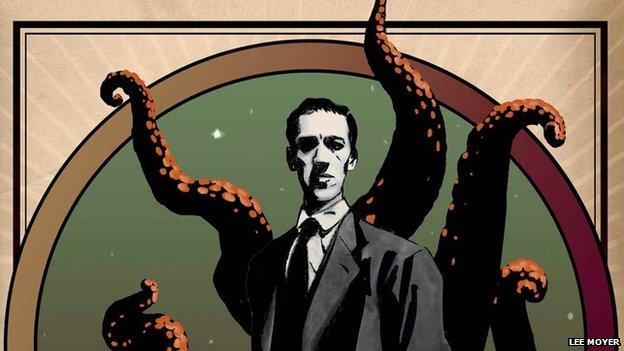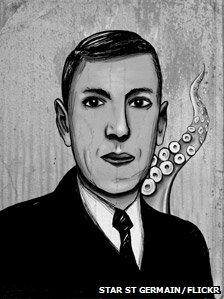HP Lovecraft: The man who haunted horror fans
- Published

Fans have been marking the death of horror writer HP Lovecraft 75 years ago. Unrecognised in his own lifetime, he has gone on to influence figures as diverse as Stephen King and Alan Moore, explains British horror writer Ramsey Campbell.
Howard Phillips Lovecraft brought the 20th Century horror story up to date, out of Victorian occultism into the realm of contemporary science without losing its sense of mystery.
His earliest stories have their roots in the Gothic novel and in the short fiction of Edgar Allan Poe.
Dagon, from 1917, is typical Lovecraft. The narrator is cast ashore on an island raised by an underwater earthquake and glimpses a giant survivor of the race which built a monolith there - froglike and fishlike, yet "damnably human".
Lovecraft developed his own invented mythology, at least as influential on fantastic fiction as Tolkien's work. Most of it is set in a New England steeped in history and in hidden occult influences, although the monstrous creatures glimpsed by his characters are frequently from outer space rather than from any conventional hell.
His fans have been adding to this body of myth for many years, and its central book of occult lore, the Necronomicon, has taken on a life of its own.
Lovecraft was born in Providence, Rhode Island, in 1890, and died there in 1937. Except for a short-lived marriage which took him to New York, he always made Providence his home.
In some ways he was a lonely figure, convinced of his own physical ugliness, but he corresponded with numerous friends, many of them writers of weird fiction - Robert Bloch of Psycho fame and Fritz Leiber were among them.
He signed himself "Grandfather" to his younger correspondents, and as teenagers, Bloch and August Derleth benefited from his criticism when they began to sell stories to Weird Tales, the pulp magazine which published most of Lovecraft's work in the field.
His criticism of his own work was harsher, and during the last years of his life he believed that almost all his tales were failures, not even worth preserving in book form. But since then he has emerged as the most influential horror writer of the 20th Century.
In 1935 he wrote "Nothing is really typical of my efforts . . . I'm simply casting about for better ways to crystallise and capture certain strong impressions (involving the elements of time, the unknown, cause and effect, fear, scenic and architectural beauty, and other seemingly ill-assorted things) which persist in clamouring for expression."
In the same letter he advised his correspondent to "avoid actually recognised myths such as vampirism, reincarnation, etc.", and praises writers he himself admires for creating "a sort of distinctive awe of their own". Much of his work seeks to convey a sense of breathless anticipation and of "dread suspense".
The Call of Cthulhu (1926) blends science fiction and an invented occultism to communicate a sense of awe and terror and in particular the enormity of the unknown universe.
It is wholly original and yet rooted in the work of authors Lovecraft admired, particularly the hints of other dimensions which English writer Algernon Blackwood conveys in The Willows (Lovecraft's favourite weird tale) and the complicated suggestive structure of Welsh author Arthur Machen's "Great God Pan".
The Call of Cthulhu is the most famous tale of his invented mythos, which is itself a stage in Lovecraft's attempts to create a perfect form for his preoccupations and for the weird tale.
The mythos was also meant to counteract the over-explanation and lack of imaginative suggestiveness he found in conventional occult fiction.
The following year Lovecraft wrote The Colour out of Space, which he later regarded as his best work. It tells the story of a strange meteorite that blights a farming community. "It was just a colour out of space", but it is Lovecraft's purest symbol, the strongest expression of his sense that the universe, and anything living out there in the dark of space or time, is indifferent to man.
The Dunwich Horror (1928) is probably his most substantial fusion of science fiction and the occult, while The Whisperer in Darkness (1930) and At the Mountains of Madness (1931) show him to be moving closer to science fiction. In the latter pair, in fact, curiosity and exploration are overcoming terror.
Even the aliens in Mountains of Madness are scientists, no longer incomprehensibly monstrous. In the last years of his life he wrote several fine tales of terror - The Shadow over Innsmouth, The Thing on the Doorstep, The Haunter of the Dark - but his best late story, the awe-inspiring "Shadow out of Time", displeased him so much that he posted the handwritten manuscript to colleague August Derleth without even keeping a copy.
"My work dissatisfies me extremely," he wrote to a correspondent, "& of late I have destroyed much more than I have saved." In March 1937 he died of intestinal cancer after a winter of agony.
The last things he wrote were a long unfinished letter and, a scientist to the end, observations on his own symptoms.
Perhaps few people other than readers of Weird Tales would ever have heard of him if it hadn't been for Derleth and Donald Wandrei, who created Arkham House to publish his collected works and showed the world that there was a market for horror in hardback.

He's long been a "fan fiction" favourite
Lovecraft has many imitators - I was one myself in my teens - but his more lasting influence is on writers who have adopted his methods to their own very individual ends.
Stephen King has written Lovecraftian tales, but they're unmistakably King - Jerusalem's Lot gives his famous fictitious town a Lovecraftian history, and Crouch End even transforms that area of London into a lair of mythos monsters.
Works by Thomas Ligotti and TED Klein, Poppy Z Brite and Alan Moore are equally personal, but still inspired by Lovecraft.
In striving to write fiction which would make positive use both of his talents and of his limitations, in particular his difficulties with creating characters, Lovecraft developed near-perfect structures for the horror story.
His determination to convey awe gives his tales a quality too seldom found. His work unites the British and American traditions of horror fiction - it unites the realistic and the fantastic, the personal and the cosmic, the occult and the scientific.